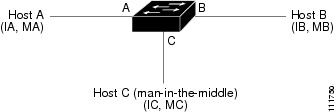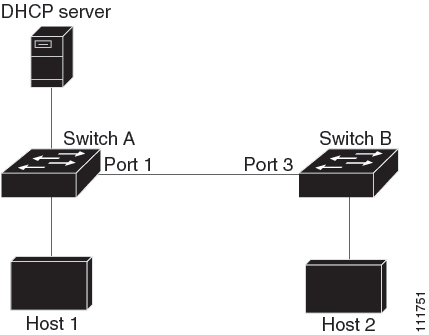In this example, the given ARP ACL is permit any any . Any incoming packet is inspected by ARP inspection enabled on VLAN 100 and permitted by this ACL rule. Hence, the ACL permit
counter is incremented as shown below (count=1) because of the permit ACL rule hit. If the rule was deny ip any any , then the ACL drop counter would have incremented as any incoming packet will hit the deny any rule.
Device# show ip arp inspection
Source Mac Validation : Disabled
Destination Mac Validation : Disabled
IP Address Validation : Disabled
Vlan Configuration Operation ACL Match Static ACL
---- ------------- --------- --------- ----------
103 Enabled Active dai-2 No
Vlan ACL Logging DHCP Logging Probe Logging
---- ----------- ------------ -------------
103 Deny Deny Off
Vlan Forwarded Dropped DHCP Drops ACL Drops
---- --------- ------- ---------- ---------
103 0 0 0 0
Vlan DHCP Permits ACL Permits Probe Permits Source MAC Failures
---- ------------ ----------- ------------- -------------------
103 0 0 0 0
Vlan Dest MAC Failures IP Validation Failures Invalid Protocol Data
---- ----------------- ---------------------- ---------------------
Vlan Dest MAC Failures IP Validation Failures Invalid Protocol Data
---- ----------------- ---------------------- ---------------------
103 0 0 0
Device# show arp access-list
ARP access list dai-2
permit ip any mac any
Device# show arp access-list
ARP access list dai-2
permit ip any mac any
Inspecting pkt from Gi2/0/12
ACL match : NACL Permit
Packet permitted by acl match.intf Gi2/0/12, linktype 1, da 00-00-5E-90-10-01
Enqueued packet in dai software queuesending packet to PI for processing with SMAC = 00-00-5E-90-10-00{mac} and SRC_ADDR = 10.5.6.7{ipv4}
0 : sec-cnt : 2, bi : 0, tot : 2
(Gi2/0/12/103)Src: 00-00-5E-90-10-00, Dst: 00-00-5E-90-10-00, SM: 00-00-5E-90-10-00, SI: 10.5.6.7, TM: 00-00-5E-90-10-00, TI: 10.2.3.4
Device# show ip arp inspection
Source Mac Validation : Disabled
Destination Mac Validation : Disabled
IP Address Validation : Disabled
Vlan Configuration Operation ACL Match Static ACL
---- ------------- --------- --------- ----------
103 Enabled Active dai-2 No
Vlan ACL Logging DHCP Logging Probe Logging
---- ----------- ------------ -------------
103 Deny Deny Off
Vlan Forwarded Dropped DHCP Drops ACL Drops
---- --------- ------- ---------- ---------
103 1 0 0 0
Vlan DHCP Permits ACL Permits Probe Permits Source MAC Failures
---- ------------ ----------- ------------- -------------------
103 0 1 0 0
Vlan Dest MAC Failures IP Validation Failures Invalid Protocol Data
---- ----------------- ---------------------- ---------------------
Vlan Dest MAC Failures IP Validation Failures Invalid Protocol Data
---- ----------------- ---------------------- ---------------------
103 0 0 0
This is an example of a case where DHCP packet is permitted. ARP inspection is enabled on the incoming VLAN 100.
The received DHCP packet is forwarded as the programmed DHCP binding table entry contains source MAC address (00-00-5E-90-10-22)
that matches the incoming ARP packet's source MAC address (00-00-5E-90-10-22). Hence, ARP inspection forwards the incoming
ARP packet and the forward count is reflected under DHCP Permits.
Device# show ip dhcp snooping bin
MacAddress IpAddress Lease(sec) Type VLAN Interface
------------------ --------------- ---------- ------------- ---- --------------------
00-00-5E-90-10-22 10.10.10.15 84239 dhcp-snooping 100 GigabitEthernet1/0/4
Total number of bindings: 1
Device# show ip arp inspection
Source Mac Validation : Enabled
Destination Mac Validation : Enabled
IP Address Validation : Enabled
Vlan Configuration Operation ACL Match Static ACL
---- ------------- --------- --------- ----------
100 Enabled Active
Vlan ACL Logging DHCP Logging Probe Logging
---- ----------- ------------ -------------
100 Deny Deny Off
Vlan Forwarded Dropped DHCP Drops ACL Drops
---- --------- ------- ---------- ---------
100 0 0 0 0
Vlan DHCP Permits ACL Permits Probe Permits Source MAC Failures
---- ------------ ----------- ------------- -------------------
100 0 0 0 0
Vlan Dest MAC Failures IP Validation Failures Invalid Protocol Data
---- ----------------- ---------------------- ---------------------
Vlan Dest MAC Failures IP Validation Failures Invalid Protocol Data
---- ----------------- ---------------------- ---------------------
100 0 0 0
Inspecting pkt from Gi1/0/4
Enqueued packet in dai software queue
DAI processing: SMAC = 00-00-5E-90-10-22{mac} and SRC_ADDR = 10.10.10.15{ipv4} DMAC = 00-00-5E-90-10-44{mac} and DST_ADDR = 10.10.10.1{ipv4}vlan: 100, if_input: Gi1/0/4
0 : sec-cnt : 2, bi : 0, tot : 2
(Gi1/0/4/100)Src: 00-00-5E-90-10-22, Dst: 00-00-5E-90-10-44, SM: 00-00-5E-90-10-22, SI: 10.10.10.15, TM: 00-00-5E-90-10-44, TI: 10.10.10.1
Device# show ip arp inspection
Source Mac Validation : Enabled
Destination Mac Validation : Enabled
IP Address Validation : Enabled
Vlan Configuration Operation ACL Match Static ACL
---- ------------- --------- --------- ----------
100 Enabled Active
Vlan ACL Logging DHCP Logging Probe Logging
---- ----------- ------------ -------------
100 Deny Deny Off
Vlan Forwarded Dropped DHCP Drops ACL Drops
---- --------- ------- ---------- ---------
100 1 0 0 0
Vlan DHCP Permits ACL Permits Probe Permits Source MAC Failures
---- ------------ ----------- ------------- -------------------
100 1 0 0 0
Vlan Dest MAC Failures IP Validation Failures Invalid Protocol Data
---- ----------------- ---------------------- ---------------------
Vlan Dest MAC Failures IP Validation Failures Invalid Protocol Data
---- ----------------- ---------------------- ---------------------
100 0 0 0
Below is an example of a case where an incoming ARP packet is dropped. ARP inspection is enabled on the incoming VLAN 100.
The received ARP packet is dropped as the programmed DHCP binding table entry contains source MAC address (00-00-5E-90-10-22)
that does not match the incoming ARP packet's source MAC address (00-00-5E-90-10-33). Hence, ARP inspection drops the incoming
ARP packet and the drop counter increment is reflected under DHCP Drops.
Device# show ip dhcp snooping bin
MacAddress IpAddress Lease(sec) Type VLAN Interface
------------------ --------------- ---------- ------------- ---- --------------------
00:00:5E:90:10:22 10.10.10.15 85920 dhcp-snooping 100 GigabitEthernet1/0/4
Total number of bindings: 1
Device# show ip arp inspection
Source Mac Validation : Enabled
Destination Mac Validation : Enabled
IP Address Validation : Enabled
Vlan Configuration Operation ACL Match Static ACL
---- ------------- --------- --------- ----------
100 Enabled Active
Vlan ACL Logging DHCP Logging Probe Logging
---- ----------- ------------ -------------
100 Deny Deny Off
Vlan Forwarded Dropped DHCP Drops ACL Drops
---- --------- ------- ---------- ---------
100 0 0 0 0
Vlan DHCP Permits ACL Permits Probe Permits Source MAC Failures
---- ------------ ----------- ------------- -------------------
100 0 0 0 0
Vlan Dest MAC Failures IP Validation Failures Invalid Protocol Data
---- ----------------- ---------------------- ---------------------
Vlan Dest MAC Failures IP Validation Failures Invalid Protocol Data
---- ----------------- ---------------------- ---------------------
100 0 0 0
Inspecting pkt from Gi1/0/16
Packet marked for log by DHCP bindings.
DHCP snooping binding failure - Dropping packet
%SW_DAI-4-DHCP_SNOOPING_DENY: 1 Invalid ARPs (Res) on Gi1/0/16, vlan 100.([00-00-5E-90-10-33/10.10.10.2/00-00-5E-90-10-44/10.10.10.1/01:04:51 UTC Wed Jul 30 2025])
Device# show ip arp inspection
Source Mac Validation : Enabled
Destination Mac Validation : Enabled
IP Address Validation : Enabled
Vlan Configuration Operation ACL Match Static ACL
---- ------------- --------- --------- ----------
100 Enabled Active
Vlan ACL Logging DHCP Logging Probe Logging
---- ----------- ------------ -------------
100 Deny Deny Off
Vlan Forwarded Dropped DHCP Drops ACL Drops
---- --------- ------- ---------- ---------
100 0 1 1 0
Vlan DHCP Permits ACL Permits Probe Permits Source MAC Failures
---- ------------ ----------- ------------- -------------------
100 0 0 0 0
Vlan Dest MAC Failures IP Validation Failures Invalid Protocol Data
---- ----------------- ---------------------- ---------------------
Vlan Dest MAC Failures IP Validation Failures Invalid Protocol Data
---- ----------------- ---------------------- ---------------------
100 0 0 0




 Feedback
Feedback